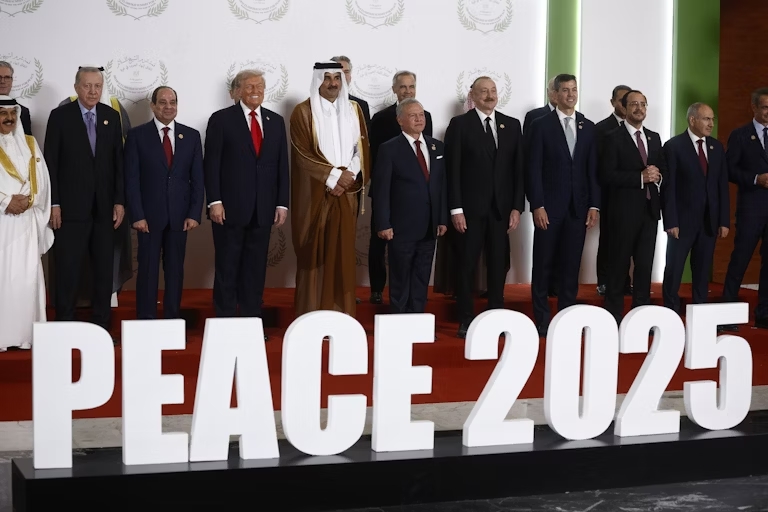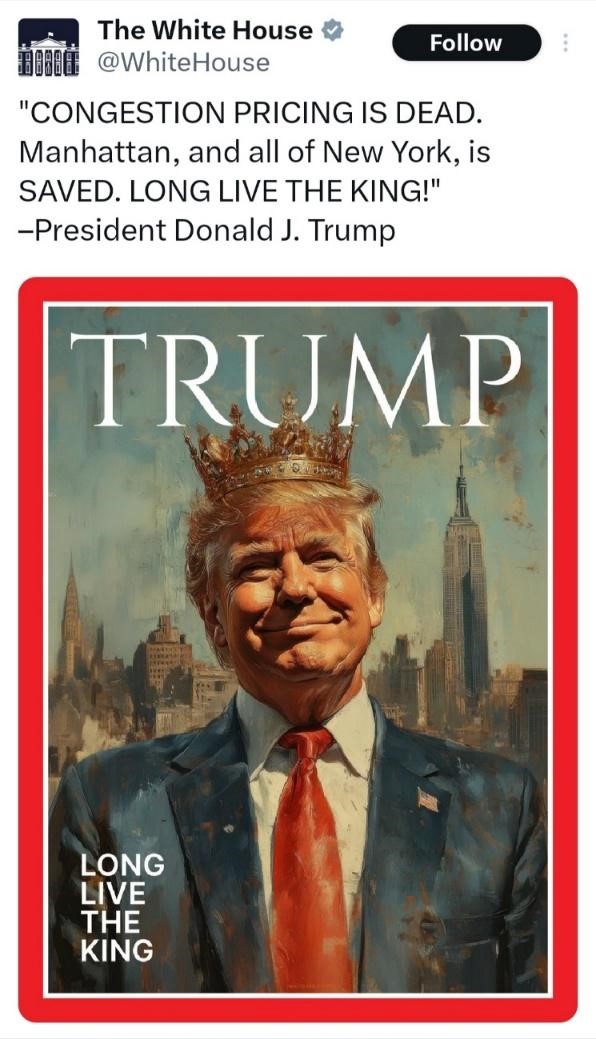As Trump’s administration barrels forward, what seemed like a potential era of isolation has become a series of interventions that seemingly have come with one single calculation resting on America’s peerless power.

There were 20 or more world leaders present for the peace summit on October 13 2025.
Donald Trump stood before cameras in February 2025 and announced his plan to seize Gaza and convert two million Palestinians into residents of “the Riviera of the Middle East.” The proposal drew laughter.
Eight months later, he forced Israel and Hamas into a ceasefire carrying his signature, imposed a prisoner exchange on his timeline, installed an international force under American command, and created a technocratic board answerable to Washington. The mockery died in silence.
This is the “Trump Corollary” in action. What began as a promise to end America’s commitments abroad has become the most assertive projection of U.S. power since the Cold War. “America First” now means “America Everywhere”—a doctrine that cloaks expansion in the rhetoric of withdrawal. Before completing his first year in office, Trump has redrawn the map of American authority, replacing the pretense of partnership with the blunt assertion of command.
The method is simple: threaten allies, strike adversaries, and move before anyone can object. No coalition-building. No multilateral consensus. No apologies. American will is sufficient. The rest is compliance.
Within hours of his second inauguration, Trump withdrew from the Paris climate accord for the second time and froze foreign aid for 90 days. He called alliances protection rackets and promised to bring troops home. Western capitals interpreted these moves as retrenchment, yet they were mistaken: instead, the Oval Office was rewriting the terms of global order.
Gaza proved the formula. Trump humiliated Hamas, constrained Israel, and claimed credit. He achieved what others failed to deliver: a truce that ended the war and placed the territory under American control. No negotiations. No concessions. Just force and timing.
The same pattern repeats across regions: threatening allies produces better results than persuading them. In Europe, Trump reversed the rules of transatlantic security, stating he would withdraw U.S. funding from NATO, then forcing members to raise defense budgets to 5 percent of GDP. He transformed a deterrence alliance into a tributary system, with European treasuries massively funding American defense priorities and industry. No speeches about shared values, no debates about common threats, and an alliance leader became alliance predator, extracting payment for protection.
In June, Trump bombed Iranian nuclear facilities and Houthi positions in Yemen. No coalition-building or Security Council debates preceded the strikes. He simply declared his prerogative and acted. The maximum pressure campaigns against regional targets gave cover to assert military action as an extension of coercive diplomacy. The message was clear: American power requires neither justification nor permission.
Even where Trump appears weakest—Ukraine—he reshapes the rules of engagement. He cannot end the war, but he forced Europe to shoulder the burden. His latest offer to sell Tomahawk missiles to Kyiv come with conditions that bind European states to endless increases in military spending. He may not save Volodymyr Zelenskyy, but shifting the cost of resisting Russia onto others bolsters his stance on who pays for European security.
Latin America reveals the doctrine at its most brutal. In January, Trump designated drug cartels as Foreign Terrorist Organizations, converting typical policing or law enforcement into military action. Washington dispatched troops, surveillance assets, and warships to patrol the Caribbean. Since September 2025, naval forces have conducted repeated airstrikes on Venezuelan vessels in the Caribbean, killing dozens without substantiating evidence. The Monroe Doctrine, once rhetoric, now arrives with cruise missiles.
At the U.N. Trump acts as a demolition crew. He vetoes resolutions, cuts funding, and compels governments into submission. In his recent address, he accused the institution of sponsoring invasions, and asked, “What is the purpose of the United Nations?” He declared climate change a “con job,” lambasted immigration advocates, and portrayed the institution as complicit in eroding sovereignty.
Ostensibly, the ivory tower of multilateralism disintegrates under his drive. By framing global institutions as adversaries to sovereign states, he collapses the architecture of collective rules, leaving only the American prerogative. Even in global health and humanitarian aid, the pattern holds: programs like PEPFAR and WHO partnerships face funding freezes and structural dismantling.

Trump’s Assertion of Unbounded Power
Trump operates through a realpolitik on steroids, by means of diplomatic hooliganism and coercive extraction, without moral cover. However, critics call him a neoconservative or an isolationist. Nine months reveal him as neither. He is a nationalist-realist who treats American power as self-justifying. He does not argue for intervention. He intervenes because he can.
The historical parallel is Theodore Roosevelt’s 1904 corollary to the Monroe Doctrine, which reserved U.S. intervention rights in Latin America to preserve order. But Roosevelt’s claim was hemispheric; Trump’s is global. Roosevelt spoke in moral terms; Trump speaks in prerogative. Like the Carter Doctrine’s assertion of Persian Gulf primacy, Trump proclaims that no region lies beyond American reach. Yet unlike Carter, he requires no reasoning beyond capacity.
The results are measurable. Gaza and Israel operate under American supervision. Iran has been struck without international approval. Europe finances NATO at unprecedented levels. Latin American waters host U.S. military jurisdiction. The UN continues to hollow out. Greenland and Panama are, for now, in the waiting list.
The major failure reminds us that coercion has limits. The tariff war with China has stalled against Beijing’s export controls on rare earth elements. But even this setback circles back to strength elsewhere: allies submit, adversaries yield, regional systems reorient to American terms.
The Legacy of the Trump Corollary
Hence, what defines this era? The Trump Corollary asserts that American power needs no rationalization. It endures by converting ideological withdrawal into material presence. It shapes the world through threat, not partnership; through supremacy, not cooperation.
Trump has become the most “interventionist isolationist” in American history. Whether one admires or despises him matters less than recognizing what he has done. Certainly, his legacy is not about ideals, but force made plain. One may say he achieved through vulgarity what others could not through sophistication. Dismissed by many as a populist demagogue, Trump has, unexpectedly, revived what the State Department spent decades trying to preserve: American primacy.
Historians may debate whether Trump destroyed the liberal order or exposed its foundational illusion. But that question misses the point. He has reactivated America’s capacity to act without permission, without apology, and without limits. Great powers, coalitions, and regional blocs may test the boundaries of his prerogative. But for now, the 47th POTUS has delivered on an inverted promise: he pledged America First, and delivered “America Everywhere”.
All in all, the world now operates under terms written in Washington, enforced through raw power, and justified only by the will to use it. Yet beneath this assertion lies an unspoken unease—the sense that these may be the last exertions of American supremacy, uncertain how long it can command obedience in a world run by orbital bipolarity.
